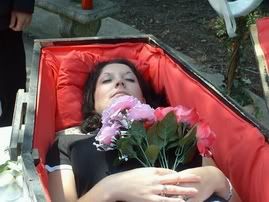A photograph of the dead person in good health is often sought in order to guide the embalmer's hand in restoring the corpse to a more lifelike appearance. Blemishes and discolorations (such as bruises, in which the discolouration is not in the circulatory system and cannot be removed by arterial injection) occasioned by the last illness, the settling of blood, or the embalming process itself are also dealt with at this time (although some embalmers utilize hypodermic bleaching agents, such as phenol based cauterants, during injection to lighten discoloration and allow for easier cosmetizing). Various funeral homes have different practices as to whether the corpse will be clothed during the time of application of the cosmetics, or whether the cosmetics will be applied first and the corpse clothed afterwards.
The foregoing describes the usual process for "cosmetic" embalming, wherein long-term preservation is not the goal; rather the natural appearance of the body is paramount.
As for clothing the body, tradition has been for the deceased to wear semi-formal clothing (a suit jacket and tie for men; a dress for women). In more recent years, the family often chooses to dress the decedent in more casual wear (such as a T-shirt and blue jeans), especially if the deceased was young. If a person is a member of the clergy of some religions, the person is often buried in religious vestments; as well, a member of the military, a police officer or firefighter is often dressed in his/her uniform.
In many areas of Asia and Europe, the custom of dressing the body in a specially designed shroud rather than in clothing used by the living is preferred.
After the deceased has been dressed, it is placed in the casket (the term casket is derived from older usage to refer to a "jewel box", it is called a coffin when the container is anthropoid in form) for the various funeral rites. It is common for photographs, notes, cards and favourite personal items to be placed in the casket with the deceased. Even bulky and expensive items, such as electric guitars, are occasionally interred with a body. In some ways this mirrors the ancient practise of placing grave goods with a person for the afterlife. In traditional Chinese culture paper substitutes of the goods are cremated with the deceased instead and Hell Bank Notes specifically purchased for the occasion.

No comments:
Post a Comment